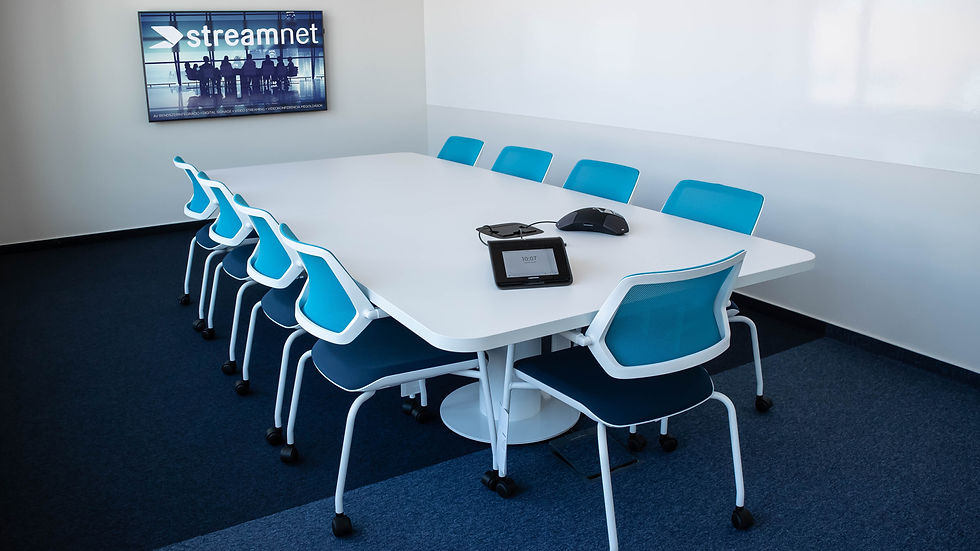
Solutions
We integrate our solutions into a unified, synergistic system based on clients’ needs, the products of leading manufacturers of the field on the market as well as our own individual developments. Our design philosophy is to combine functionality, usability and technical prowess with appearance, ergonomics and design.




Meeting rooms
Meeting rooms are the information hubs of modern offices and in many ways they are the company’s interface with the outside world and the employees. Meeting rooms are enclosed spaces of varying capacity where employees can collaborate effectively with colleagues and clients in attendance, as well as those joining through video conferencing.
The task of technology is to unobtrusively support the creative flow of information, by turning it on and using it meaningfully, instead of taking up valuable time from meetings; the usability should be optimal compared to the size of the room, and the energy consumption should be as low as possible.




Board rooms
The management meeting room is the center of the company, the management and the board of directors hold meetings and they also meet the most important customers here. Larger, more serious technical equipment and typically more exclusive construction demands require individual solutions.




Huddle space
Areas suitable for group work in an open space are referred to as collaboration space (huddle space). Unlike the classical meeting room, their design is usually looser and more varied, but at the same time, they must also be able to involve remote team members. The latter is particularly challenging in terms of sound: it should be audible, yet without disturbing those working nearby.




Project and training rooms
The characteristic of project and training rooms is that their equipment and rearrangement require great flexibility, therefore we usually forgo installing technical equipment in the furniture. Larger displays are usually equipped with a touch screen and it’s also important to have many large, digitally usable interfaces. Of course, there is also a need for remote users to connect, which can be a challenge when installing a camcorder. Essential accessories for lectures include the pulpit and the possibility of streaming.


Auditoriums
Auditoriums are typically suitable for hosting large-scale lectures and they can often be converted into smaller training rooms with the help of mobile walls. The display usually requires a projector or a video wall made of thin-film monitors, or a high-brightness, spectacular LED wall. When comes to the PA system, it is extremely important to provide amplification that takes into account the acoustic characteristics of the room and is free from any feedback, while remaining clearly audible from all points in the room. In modern auditoriums, it is essential to integrate the tools for the high-quality streaming of lectures, and a smaller studio can greatly enhance the quality of this service.


Studios
For the professional support, recording, transmission and editing of lectures and trainings in lecture halls and stages, it is necessary to create a studio room. This provides space for staff, equipment and controls.
The studio room functions just like a small television studio, from where the output stream can be sourced from the images of the cameras and the sounds of the microphones, while also monitoring the cameras and mixing effects, etc. The recording of the video(s) as well as their subsequent editing and subtitling take place here. These tasks are resolved digitally with special software, yet with a standard computer infrastructure.


Control room
Control rooms are typically used for 24-hour monitoring of manufacturing processes, security technology, and other surveillance systems.
These rooms typically allow monitoring processes via large displays, a monitor wall, or a LED wall for good visibility. The control rooms must meet two somewhat conflicting needs. The solution must provide physically comfortable, reliable support for extended monitoring periods, as well as the capability to intervene quickly in the event of an incident and to ensure the transparency of events. For this purpose, in addition to basic quality requirements and the professional design of the audio-visual environment, the ergonomic aspects are extremely important, which we implement individually by assessing the customer’s needs.


Showroom
The showroom is an exclusive part of the office where our clients use state-of-the-art technology to share their vision with their clients, so in addition to their own products and solutions, spectacular displays, projectors, light and sound systems tend to play a major role.


Digital signage
Digital content delivery devices attract the attention of employees and customers at busy points in offices and shops. These typically include displays, possibly video or LED walls, displaying advertisements or information of public interest, even about a specific location. The content that appears can be pre-programmed, scheduled, or triggered by an event, but it can also display real-time information such as stock exchange rates, weather or the escape route in an emergency.




Video streaming
Typical fields of application for video streaming include conferences, events, press conferences, trainings, presentations over the Internet or corporate events, executive communications, trainings, broadcasting newly recruited employee trainings, internal PR over the corporate network, or encrypted over the Internet. This can function like a self-owned digital television channel that everyone can watch at work or from home at the same time, even from recording; however, viewers must be able to provide interactive feedback to the lecturer.
Together with Videosquare, our partner company, we have the ability to fully organize streaming lectures or set up a video studio or lecture hall capable of streaming at our customer’s site.